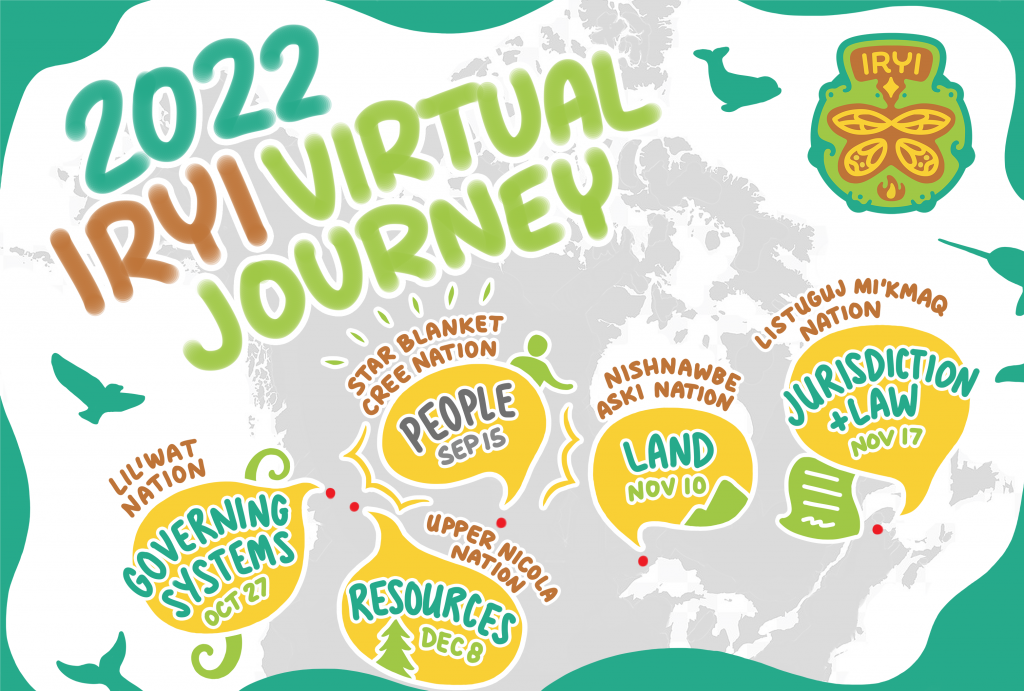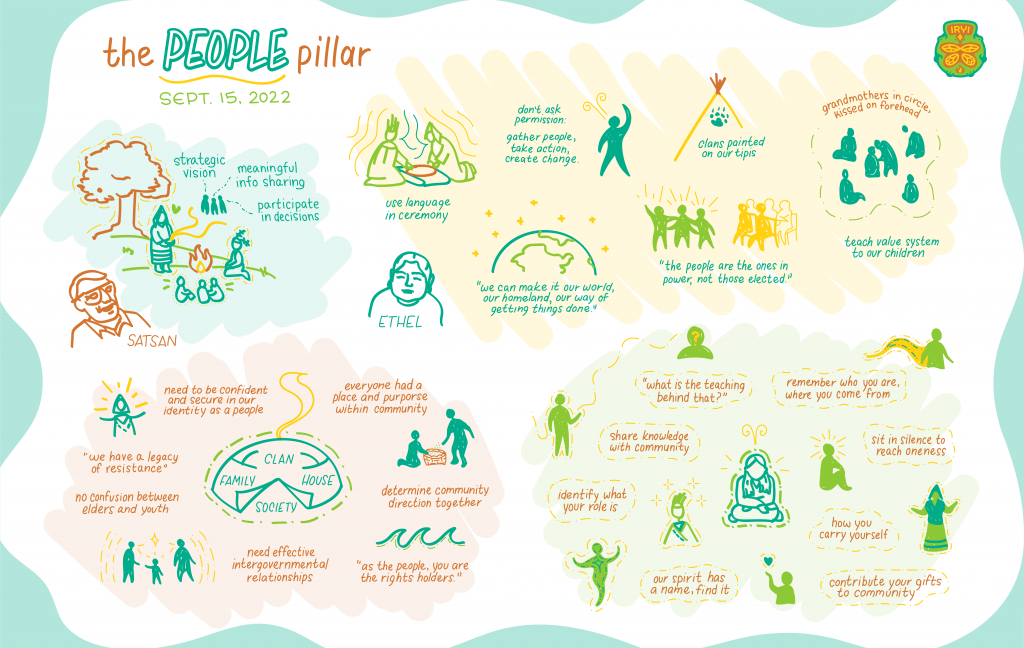
Graphic Harvesting by Patuo’kn
FIRST NATIONS YOUTH AND ELDERS GATHER FOR FIRST INHERENT RIGHTS YOUTH INITIATIVE STORYTELLING SESSION
Article by Ben Sylvestre
A thin trail of smoke streamed into the frame of Elder Jerry Fontaine’s video feed. An unseen bundle of medicines burned in the smudge bowl on the table before him. Two-dozen people videoing-in from First Nations across Turtle Island listened closely as he offered an opening prayer in Anishinaabemowin.
Fontaine’s words opened the first in a series of online storytelling sessions for Indigenous youth and Elders hosted by the Inherent Rights Youth Initiative (IRYI). Each of the sessions will equip young Indigenous leaders with knowledge and skills to lead the future of self-determining First Nations governments in Canada.
>> REGISTER FOR DECEMBER 8TH SESSION<<
“We need to train a new generation of inherent rights leaders. And that’s what this is all about,” said Satsan (Herb George), founder of the Centre for First Nations Governance (CFNG). “Because what we’re up against in terms of rebuilding our nations is not only going to take hard work and discipline and commitment, it may take several generations to do.”
IRYI is a joint project spearheaded by CFNG in collaboration with The Rebuilding First Nations Governance Project, Laidlaw Foundation, and The Institute of Public Administration of Canada (IPAC).
The initiative began in 2021 with a series of successful events connecting Indigenous youth with Elders with a vision to reclaim and rebuild Indigenous identities by strengthening connections to lands, languages, ceremonies and histories. This year, IRYI is hosting five virtual storytelling sessions in the fall and early winter 2022, leading up to a virtual Youth and Elders Gathering in early January, 2023.
First Nations youth and Elders can still register to join the half-day virtual sessions: as Satsan explained to attendees, First Nations are in dire need of more self-government leaders with skills and information to guide their communities.
“I’m really honoured that you’re with us today and through the course of these six sessions that we’re going to do,” said Satsan “And I hope that you will bring others with you because we desperately need you all.”
The People Pillar

Graphic Harvesting by Patuo’kn
Each of the five storytelling sessions connects youth with Elders to explore one of The Five Pillars of Effective Governance, how it played a role in their lives, and how it will play a role in First Nations’ futures. The inaugural session spotlighted “The People,” the first of the five pillars.
CFNG created the pillars with the help of First Nations citizens, leaders, Elders, and academics. “The People” and the other pillars—The Land, Jurisdiction and Laws, Governing Systems, and Resources—are the five essential aspects of all First Nations’ past and present self-governments.
As the leaders of the future, Indigenous youth will need to understand how to govern their communities and protect their rights. The storytelling sessions aim to prepare them to build upon the legacy of First Nation-self government since time immemorial and rebuild what their communities lost to colonialism.
“We can come together and learn together—learn to rebuild our nations— because our young people deserve it now,” said Satsan. “And we need to put this in place forever into the future.”
Who We Are
“When I was eight years old—when my father was chief for many, many years— growing up, I begged him to teach me the way he was teaching my older brothers,” said Elder Ethel Dubois of Star Blanket Cree Nation. “And he did.”
Now decades later, having used this knowledge to build an over 25-year career in social work supporting First Nations communities, Dubois appeared on- screen at the ceremonial gathering as its guide and storyteller. She wore a bright yellow t-shirt in a white-walled meeting room on Star Blanket territory.
Dubois explained how the power of the people is rooted in their understanding of their identity—who they are and where they come from. The Elder recalled when she first learned this lesson herself.
“When I was five years old, the old grandmothers sat in a circle. And they kissed me on the forehead and said a prayer,” she said. “And by the time I got to my paternal grandmother, she said ‘Do you know who you are?’ in Cree.”
“She instilled in me my identity—my Indigenous roots I was never ever to forget.”
Dubois says knowing who you are as a First Nations person means thinking beyond your community and the boundaries set out by the Indian Act. All
Indigenous people come from Turtle Island, and all Indigenous nations are in relation to one another as communities sharing the land.
The People Pillar is about creating action through the power of people coming together. Dubois’s role at the gathering was to share her experiences, build collective identity, and ignite collective action.
“When you gather the people, gather the community in a nonthreatening way, you will get the answers for change,” she said. “A lot of our mindset right now is having to ask permission—we don’t have to do that anymore. We don’t have to ask permission for anything. We have to take action.”
And…Action
That’s where the youth come in. After hearing Elder Dubois’ stories, participants broke into small groups to parse out how what had been shared connected with their own past, present, and future.
“We were talking about how there’s different aspects of the People Pillar that Indigenous people uphold…one of the main things that stood out was our different roles that we play in our communities and then our nations,” said Haida Nation representative, Gaawee Jaad (Serena Smith). “Each of us have a role to play in our communities. And it’s important for us to find them.”
Youth reported finding common ground with other youth from different nations and highlighted that their peers shared the same struggles, histories, responsibility, or drive for change.
“We were talking about how we want…learn more, learn more about ourselves, you know, through immersing ourselves within culture and even learning from one another like in the sessions here,” said Cowessess Nation representative Darian âcikahtê (Agecoutay).
And as Elder Dubois explained, knowing yourself and your people is the first action towards rebuilding First Nations governance.
“The first thing is to try and get to your identity, know who you are, where you come from, and how you’re going to make things happen,” she said.
For information on how to join future IRYI storytelling sessions and other gatherings, please visit our events webpage.
Read more about youth leadership and meet IRYI coordinator Amsey Maracle in our new Q&A series—The Pathfinders.
Follow us on Facebook
